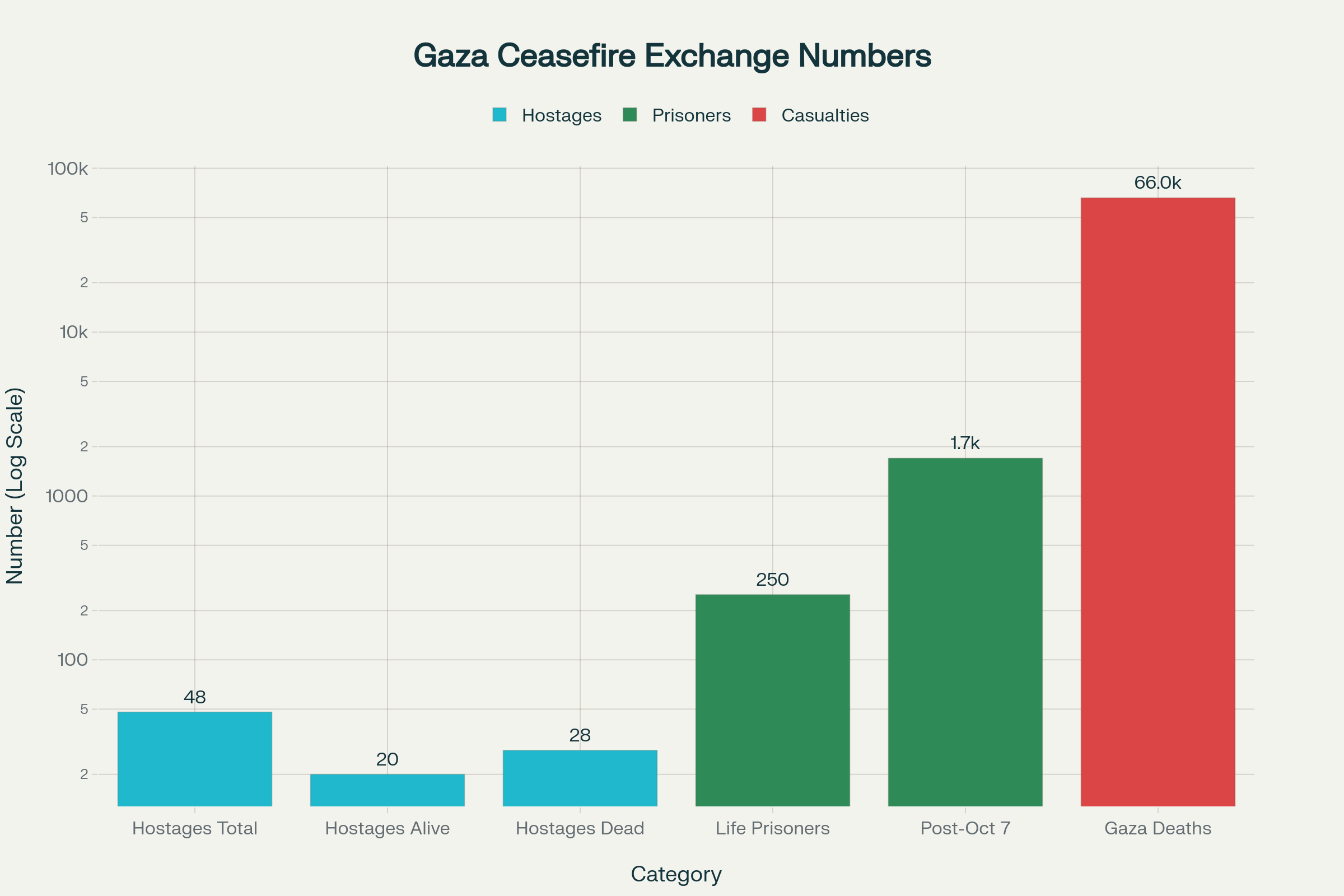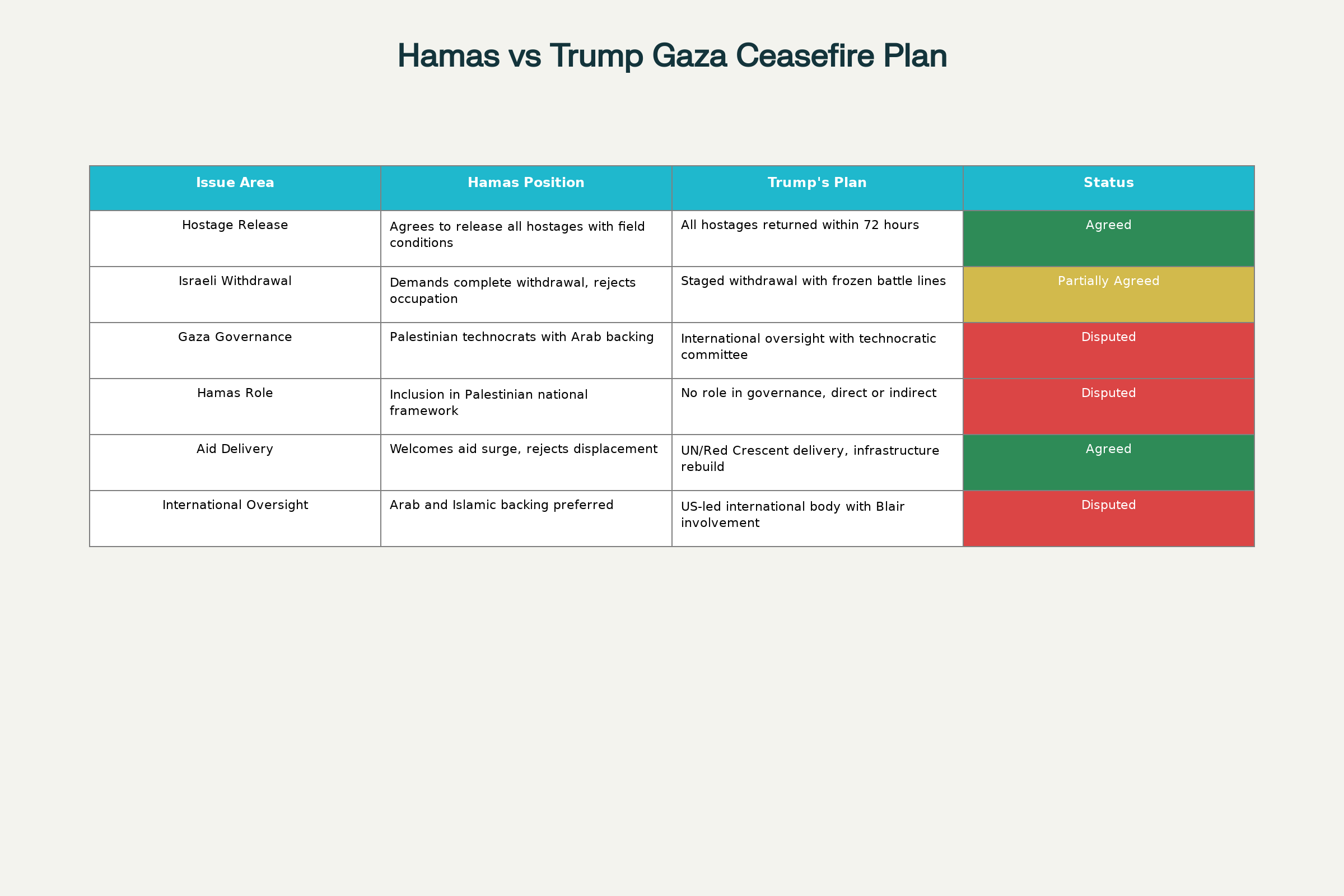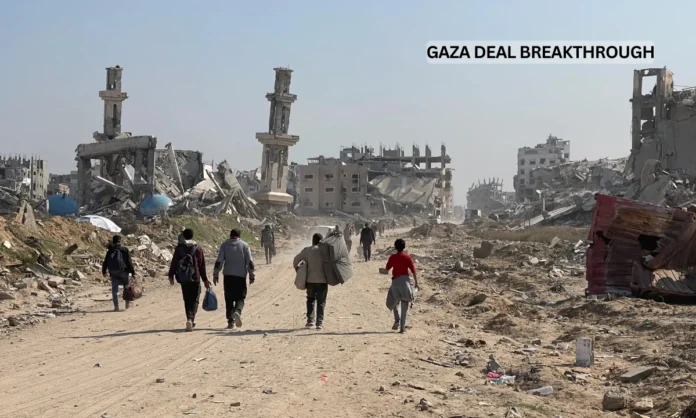Key Highlights:
- Hamas accepted core elements of Trump’s Gaza ceasefire plan including hostage release and Israeli withdrawal but demands further talks on governance
- The Gaza ceasefire plan requires release of 48 Israeli hostages within 72 hours in exchange for 1,950 Palestinian prisoners
- International coalition of 15+ nations endorsed the Gaza ceasefire plan as WHO reports over 66,000 Gaza deaths
Opening Overview
Hamas has conditionally endorsed significant components of President Trump’s comprehensive Gaza ceasefire plan while signaling substantial reservations about governance arrangements that require continued negotiation. The Palestinian militant organization’s Friday statement represents the most substantial progress toward implementing a Gaza ceasefire plan since conflict escalation began, with Hamas specifically agreeing to release all Israeli hostages under Trump’s proposed framework.
Hamas did not accept Trump’s plan. It said, predictably, that it was willing to negotiate it. I don’t know why the President is awarding Hamas a unilateral ceasefire just so it can buy time while torturing the hostages. I hope there’s something behind the scenes we don’t know. pic.twitter.com/5PtBvIK2KV
— Eylon Levy (@EylonALevy) October 4, 2025
This partial acceptance comes after Trump issued a Sunday evening ultimatum, warning of severe consequences if parties fail to reach agreement. The acceptance marks critical movement in ending hostilities that have devastated Gaza, with WHO confirming over 66,000 Palestinian deaths and 170,000 injuries requiring immediate humanitarian intervention. Hamas emphasized readiness for immediate mediated discussions to finalize implementation while maintaining core demands regarding Gaza’s future political structure.
Hostage Release and Prisoner Exchange Mechanisms
- Hamas committed to releasing all 48 remaining Israeli hostages according to the Gaza ceasefire plan exchange formula
- The framework mandates hostage return within 72 hours followed by release of 1,950 Palestinian prisoners
Hamas declared willingness to release Israeli hostages “according to the exchange formula contained in President Trump’s proposal, with the necessary field conditions for implementing the exchange” under the framework. The organization emphasized readiness for immediate negotiations through mediators to discuss detailed implementation procedures. Trump’s proposal specifies that all hostages must be returned within 72 hours of Israel publicly accepting the comprehensive agreement.
The prisoner exchange component involves substantial releases by Israel in return for hostage freedom. According to official documentation, the Gaza ceasefire plan requires Israel to free 250 Palestinian prisoners serving life sentences plus 1,700 Gazans arrested since October 7, 2023, including all women and children. The framework also establishes that for every Israeli hostage whose remains are released, Israel will return the remains of 15 deceased Palestinians.
Current intelligence indicates 48 hostages remain in Hamas custody, with estimates suggesting only 20 are believed alive while 28 are presumed deceased. The prisoner exchange represents one of the largest such arrangements in recent Middle East diplomatic history, involving nearly 2,000 Palestinian detainees.

Gaza Ceasefire Plan: Hostage and Prisoner Exchange Numbers
Hamas’s conditional acceptance of the exchange mechanism represents significant movement from previous negotiating positions, though the organization did not specify what constitutes “necessary field conditions” for implementation. The group’s willingness to engage in immediate discussions through established mediation channels indicates potential for rapid progress.
Israeli Withdrawal and Military Cessation Framework
- Hamas accepted the framework for ending war and achieving complete Israeli military withdrawal
- The Gaza ceasefire plan calls for staged withdrawal with frozen battle lines until comprehensive conditions are satisfied
The acceptance by Hamas encompasses the fundamental framework for terminating military operations and securing full Israeli withdrawal from Gaza territory. Hamas explicitly stated acceptance of ending the war and Israel’s “full withdrawal” from the enclave while categorically rejecting any form of continued Israeli occupation. This represents substantial alignment with core objectives outlined in Trump’s comprehensive proposal.
Trump’s staged withdrawal approach specifies that “Israeli forces will withdraw to the agreed upon line to prepare for a hostage release”. During this implementation period, all military assault including aerial and artillery bombardment will be suspended, with battle lines remaining frozen until complete withdrawal conditions are satisfied. The framework emphasizes immediate cessation of all hostilities upon both parties’ formal acceptance.
The framework reveals differences between Hamas’s statement and Trump’s proposal regarding withdrawal staging. While the Gaza ceasefire plan outlines phased withdrawal with specific benchmarks, Hamas did not acknowledge different stages and emphasized complete rejection of continued Israeli occupation. This discrepancy represents a crucial area requiring intensive negotiation within the broader implementation process.
International monitoring mechanisms form an integral part of the structure, though Hamas notably did not comment on proposed deployment of a “temporary International Stabilisation Force” that Trump envisions with Arab partner collaboration. This silence on international oversight may indicate Hamas concerns about external military presence.
Humanitarian Aid and Population Protection Provisions
- Both parties agreed on provisions for massive humanitarian aid surge and rejection of Palestinian expulsion
- The Gaza ceasefire plan mandates aid delivery through UN, Red Crescent, and international institutions with comprehensive infrastructure rehabilitation
The framework includes extensive humanitarian provisions that both Hamas and Trump’s administration have endorsed as essential for post-conflict recovery. Hamas welcomed Trump’s emphasis on substantial aid increases into Gaza while appreciating the explicit rejection of Palestinian population displacement. The organization stated firm opposition to Palestinian expulsion from Gaza territory under any arrangement.
Trump’s humanitarian framework mandates immediate aid delivery “in quantities consistent with a January 19 agreement” while establishing comprehensive reconstruction protocols. The Gaza ceasefire plan encompasses rehabilitation of critical infrastructure including hospitals, bakeries, water systems, electricity networks, and sewage facilities. Essential equipment for debris removal and road restoration forms a central component of the humanitarian package.
The humanitarian component operates through established international channels to ensure systematic distribution. Aid delivery will proceed through the United Nations, Red Crescent, and other international institutions under the framework. This multi-institutional approach aims to guarantee transparent and efficient humanitarian assistance delivery throughout implementation.
WHO data reveals the immense humanitarian need within the context, with over 66,000 Palestinians killed and 170,000 injured requiring extensive medical rehabilitation services. The framework must address that only 14 of Gaza’s 36 hospitals remain partially functional, with 1,719 verified attacks on healthcare facilities documented during the conflict. These humanitarian provisions directly address critical infrastructure and medical reconstruction needs.
| Humanitarian Priority | Current Status | Target | Implementation Timeline |
|---|---|---|---|
| Hospital Functionality | 14 of 36 partially operational | Full restoration of 36 facilities | Phase 1: 90 days |
| Water System Access | 30% population coverage | 100% population access | Phase 2: 180 days |
| Electricity Grid | 4-6 hours daily | 24-hour reliable supply | Phase 3: 365 days |
| Food Distribution | 1.2 million facing famine | Complete food security | Immediate |
| Medical Supplies | Critical shortage | Full pharmaceutical access | 30 days |
Gaza Governance Disputes and Administrative Control
- The most significant disagreement concerns future governance structure and Hamas’s political participation
- Trump’s Gaza ceasefire plan demands Hamas relinquish all governance roles while Hamas seeks inclusion in Palestinian national framework
The most substantial divergence concerns Gaza’s future governance arrangements and Hamas’s continued political involvement in territorial administration. Trump’s proposal establishes “temporary transitional governance of a technocratic, apolitical Palestinian committee” supervised by an international body that Trump would personally lead, including prominent figures like former UK Prime Minister Tony Blair. This structure represents direct international oversight of Gaza’s administrative functions.
Hamas’s position differs fundamentally regarding governance transition mechanisms. The organization agreed to transfer Gaza administration “to a Palestinian body of independents (technocrats) based on Palestinian national consensus and supported by Arab and Islamic backing”. This formulation emphasizes Palestinian national consensus rather than international supervision outlined in Trump’s approach.

Comparison of Hamas Position vs Trump’s Gaza Ceasefire Plan Key Elements
The fundamental contradiction involves Hamas’s future political role in Gaza. Trump’s proposal explicitly states Hamas must “agree to not have any role in the governance of Gaza, directly, indirectly, or in any form”. Additionally, the framework demands “a process of demilitarisation of Gaza” that Hamas has not addressed. Hamas maintained it sees itself as part of a “comprehensive Palestinian national framework” under any arrangement.
Hamas’s statement emphasized that governance discussions must occur “within a comprehensive Palestinian national framework, in which Hamas will be included and will contribute with full responsibility”. This directly contradicts Trump’s demand for Hamas exclusion from all governance roles within the structure. The organization also did not address Trump’s proposal offering amnesty and safe passage for Hamas members who “decommission” their weapons.
International Support and Implementation Framework
The Gaza ceasefire plan has secured unprecedented international endorsement from major global powers spanning multiple continents. A joint statement from Foreign Ministers of Qatar, Jordan, UAE, Indonesia, Pakistan, Turkey, Saudi Arabia, and Egypt welcomed Trump’s leadership and expressed confidence in achieving regional peace through the framework. European leaders including French President Macron, German Foreign Minister Wadephul, and Italian Prime Minister Meloni have formally endorsed the structure.
Additional support extends globally, with backing from Indian Prime Minister Modi, Japanese Prime Minister Ishiba, Canadian Prime Minister Carney, and UK Prime Minister Starmer. This broad international coalition provides substantial diplomatic momentum for implementation despite remaining disagreements between primary parties. The international support structure creates multiple diplomatic channels for resolving outstanding disputes.
The implementation timeline faces critical pressure with Trump’s Sunday evening deadline approaching rapidly. International mediators are intensifying efforts to bridge remaining gaps between Hamas and Israeli positions on governance arrangements. Success depends on both parties’ willingness to compromise on administrative structures while maintaining their fundamental security and political objectives.
Gaza Ceasefire Plan Final Assessment
The Gaza ceasefire plan represents the most significant diplomatic breakthrough toward ending the devastating Gaza conflict, with Hamas accepting crucial elements including comprehensive hostage release, Israeli military withdrawal, and extensive humanitarian aid provisions. However, fundamental disagreements persist regarding Gaza’s future governance structure and Hamas’s political role, requiring intensive negotiations to bridge these substantial gaps within the framework. With unprecedented international support spanning 15+ nations and Trump’s Sunday deadline creating urgent pressure, the proposal offers genuine hope for ending a conflict that has devastated Palestinian society and displaced over two million people.
The ultimate success depends on both parties’ capacity to reach acceptable compromises on governance arrangements while ensuring security guarantees and humanitarian recovery in the implementation phase. The broad international backing provides essential diplomatic infrastructure for sustained peace, though execution will require careful management of competing political and security interests from all stakeholders involved in this historic agreement.


